2018 School Spending Survey Report
What Makes a Good Rock-and-Roll Book?
Every time critics and writers declare rock-and-roll dead, it rises again; re-tuned, rebranded, and repackaged for a new generation.
The children’s publishing industry is slowly catching up to the trend. Although many “flavor of the month” pop music biographies are published every year (such as Scholastic’s Star Scene series), the number of informative and beautifully illustrated rock-and-roll books for children is still limited. Nevertheless there are a variety of indispensable books, both fiction and nonfiction, for preschoolers to fifth graders that explore rock’s history and its famous legends, celebrating the timeless — and ageless — joy of rock-and-roll rebellion.
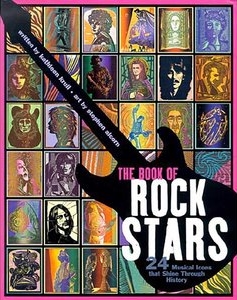 Kathleen Krull and illustrator Stephen Alcorn create one of the most comprehensive collections of rock legends for young readers in The Book of Rock Stars: 24 Musical Icons That Shine Through History. Beginning with Elvis and ending with Kurt Cobain, one-page biographies (the Beatles get two and a half pages) chronologically trace the history of rock through the story arcs of its famous innovators. Krull explores the visionary work of each artist, highlighting his or her personal story and musical influences. Acknowledging in her introduction that “not all parents will love this book” because of some of the performers’ less dignified moments, she shines light on the dark matter without judgment in an honest, age-appropriate way for third grade and up. Alcorn’s busy polychrome relief-block prints give each personality a reverential air, freezing the gods and goddesses of rock in swirling psychedelic colors, while adorning them with Greek and religious imagery. The book includes a well-considered bibliography and three or four of each artist’s groundbreaking albums. Any young rock star will pore over these pages in awe.
Kathleen Krull and illustrator Stephen Alcorn create one of the most comprehensive collections of rock legends for young readers in The Book of Rock Stars: 24 Musical Icons That Shine Through History. Beginning with Elvis and ending with Kurt Cobain, one-page biographies (the Beatles get two and a half pages) chronologically trace the history of rock through the story arcs of its famous innovators. Krull explores the visionary work of each artist, highlighting his or her personal story and musical influences. Acknowledging in her introduction that “not all parents will love this book” because of some of the performers’ less dignified moments, she shines light on the dark matter without judgment in an honest, age-appropriate way for third grade and up. Alcorn’s busy polychrome relief-block prints give each personality a reverential air, freezing the gods and goddesses of rock in swirling psychedelic colors, while adorning them with Greek and religious imagery. The book includes a well-considered bibliography and three or four of each artist’s groundbreaking albums. Any young rock star will pore over these pages in awe.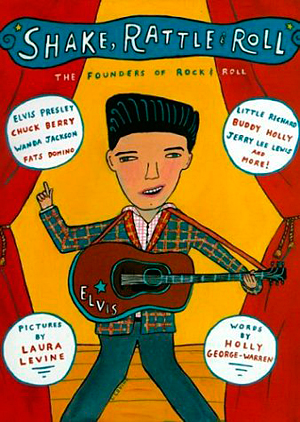
Not far behind is Holly George-Warren’s Shake, Rattle & Roll: The Founders of Rock & Roll, an entertaining primer that spotlights rock’s original heavyweights. In concise one-page summaries, George-Warren provides vital statistics, presents an overview of the artists’ upbringing and musical influences, and lists the artists’ hit songs. The nearly incalculable debt owed to African Americans and women is acknowledged in this book, with Fats Domino, LaVern Baker, Little Richard, Chuck Berry, Bo Diddley, Wanda Jackson, and James Brown rightfully included. More obvious choices such as Elvis Presley, Buddy Holly, Ritchie Valens, and Jerry Lee Lewis are on the bill as well. Laura Levine’s mixed-media folk-art-like illustrations offer a joyful brightness that mirrors their subjects, with song lyrics and other details peppered throughout the framed pieces.
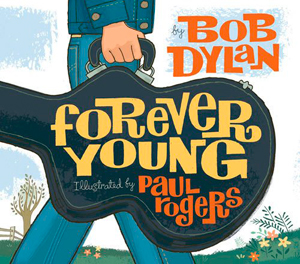
Individual rock legends have found their way into children’s books, too. In Forever Young, illustrator Paul Rogers uses the lyrics of Bob Dylan’s 1974 song of the same title to compose a sweet homage to a living legend. Rogers re-creates 1950s and 1960s New York City with muted colors and sharp lines, giving it an earthy, retro vibe. Against the backdrops of Greenwich Village and Washington Square Park, two folk music flashpoints at the time, the story follows a young Dylan: obsessed with luminaries such as James Dean and Odetta, influenced by rural folk and blues music and the era’s cultural and political upheavals, the singer-songwriter begins playing his songs around New York and eventually travels to Washington, D.C., to join in protests and peace rallies.
The illustrator’s intricate knowledge of the time period and his subject is impressive, as the who’s-who of important figures that helped shape Dylan’s creative universe populate the pages. Jack Kerouac, Joan Baez, and many more make cameos. Even the books on the young Dylan’s shelf match a Dylan lyric, with Ezra Pound sitting alongside T. S. Eliot (“And Ezra Pound and T. S. Eliot / Fighting in the captain’s tower” from the song “Desolation Row”). Such details make this book a standout addition to the mountain of critical and biographical literature on Bob Dylan.
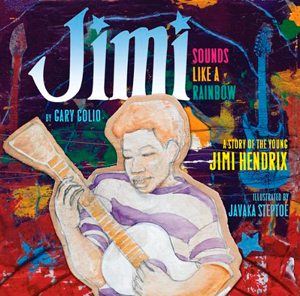 Whenever he’s asked to name his favorite guitar player of all time, Paul McCartney doesn’t hesitate: it’s Jimi Hendrix. The formative years of the legendary guitarist are explored in Gary Golio’s Jimi: Sounds Like a Rainbow: A Story of the Young Jimi Hendrix. A Coretta Scott King Award Honor book, it tells the story of a young Hendrix in a colorful and poetic way, portraying him as a fiery kid who had rock-and-roll dreams much earlier than casual fans might realize. Using the “colors of sound” rainbow theme throughout, the book crackles like an old Tweed amplifier with Hendrix discovering rural blues music, Elvis Presley, and Howlin’ Wolf while growing up in 1950s Seattle. Golio describes Hendrix’s guitar playing so vividly that readers are sure to be left craving the albums to round out the experience (proof positive: I’ve had Axis: Bold as Love on repeat for the last few weeks).
Whenever he’s asked to name his favorite guitar player of all time, Paul McCartney doesn’t hesitate: it’s Jimi Hendrix. The formative years of the legendary guitarist are explored in Gary Golio’s Jimi: Sounds Like a Rainbow: A Story of the Young Jimi Hendrix. A Coretta Scott King Award Honor book, it tells the story of a young Hendrix in a colorful and poetic way, portraying him as a fiery kid who had rock-and-roll dreams much earlier than casual fans might realize. Using the “colors of sound” rainbow theme throughout, the book crackles like an old Tweed amplifier with Hendrix discovering rural blues music, Elvis Presley, and Howlin’ Wolf while growing up in 1950s Seattle. Golio describes Hendrix’s guitar playing so vividly that readers are sure to be left craving the albums to round out the experience (proof positive: I’ve had Axis: Bold as Love on repeat for the last few weeks).Javaka Steptoe’s colorful mixed-media plywood art explodes off the page. His earthy, psychedelic folk art matches Golio’s poetic treatment of his subject beautifully, capturing Hendrix’s sound with arresting visuals. Steptoe includes a fascinating illustrator’s note, detailing his exhaustive research into Hendrix’s life and music. The book could have multiple uses in the classroom, from music appreciation to an art unit on colors and/or collage. For fun, gift this book with the CD reissue of Are You Experienced? and you’ll be the coolest relative of any young guitarist.
 Although you might not believe Elvis was recently seen washing his car in Toledo, the King lives on in Shake, Rattle & Turn That Noise Down!: How Elvis Shook Up Music, Me and Mom. Cartoonist Mark Alan Stamaty’s touching mini graphic novel memoir details when, as an eight-year-old in 1955, he was introduced to rock-and-roll and the music of Elvis Presley through a tiny transistor radio. The new, rocking sound of Elvis sends Stamaty’s mother into a tizzy of confusion and fear, setting up a classic “us vs. them” scenario, with mom criticizing what she can’t understand (to paraphrase Bob Dylan, another Elvis disciple) and Stamaty desperately trying to explain why he’s all shook up. In the end, Elvis and his young fan win Mom over. The sweetness of this mother-son relationship shimmers throughout the story (the book is dedicated to her). Within his own personal history, Stamaty highlights the diverse list of musical performers who all owe a debt to the King. His vivid illustrations burst within the panels.
Although you might not believe Elvis was recently seen washing his car in Toledo, the King lives on in Shake, Rattle & Turn That Noise Down!: How Elvis Shook Up Music, Me and Mom. Cartoonist Mark Alan Stamaty’s touching mini graphic novel memoir details when, as an eight-year-old in 1955, he was introduced to rock-and-roll and the music of Elvis Presley through a tiny transistor radio. The new, rocking sound of Elvis sends Stamaty’s mother into a tizzy of confusion and fear, setting up a classic “us vs. them” scenario, with mom criticizing what she can’t understand (to paraphrase Bob Dylan, another Elvis disciple) and Stamaty desperately trying to explain why he’s all shook up. In the end, Elvis and his young fan win Mom over. The sweetness of this mother-son relationship shimmers throughout the story (the book is dedicated to her). Within his own personal history, Stamaty highlights the diverse list of musical performers who all owe a debt to the King. His vivid illustrations burst within the panels.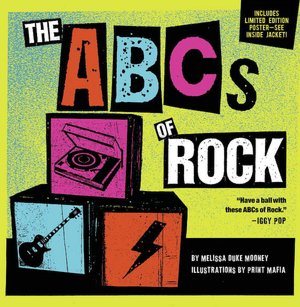 Very young children have some rocking selections, too. In The ABCs of Rock, Melissa Duke Mooney and the DIY screen print company Print Mafia have created, quite possibly, the most punk ABC board book ever. “A” could be for apple, but to Mooney it’s for the band AC/DC. “C” is for the Clash, and so on. The art is gritty and crusty, like a crude photocopied show flyer disintegrating on a telephone pole. Each letter includes a few visual details about the artist it represents, such as Elvis Costello’s signature black-rimmed glasses. If you’re looking for a quirky read-aloud or the perfect baby shower book for punk rock parents, this is it.
Very young children have some rocking selections, too. In The ABCs of Rock, Melissa Duke Mooney and the DIY screen print company Print Mafia have created, quite possibly, the most punk ABC board book ever. “A” could be for apple, but to Mooney it’s for the band AC/DC. “C” is for the Clash, and so on. The art is gritty and crusty, like a crude photocopied show flyer disintegrating on a telephone pole. Each letter includes a few visual details about the artist it represents, such as Elvis Costello’s signature black-rimmed glasses. If you’re looking for a quirky read-aloud or the perfect baby shower book for punk rock parents, this is it.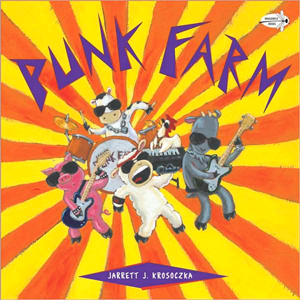 In the fiction picture book world, Jarrett J. Krosoczka’s Punk Farm and the sequel Punk Farm on Tour provide a double shot of rock-and-roll read-aloud craziness. Animals on a Wisconsin farm start a punk rock band (unbeknownst to Farmer Joe). They practice regularly and perform live for adoring crowds. The band looks sharp, dressed in a mash-up of signature styles, such as Born in the U.S.A. bandannas, punk rock chains (with cowbells instead of padlocks), and striped ties straight out of the new wave eighties. Topping it off, each animal hides behind a pair of dark sunglasses.
In the fiction picture book world, Jarrett J. Krosoczka’s Punk Farm and the sequel Punk Farm on Tour provide a double shot of rock-and-roll read-aloud craziness. Animals on a Wisconsin farm start a punk rock band (unbeknownst to Farmer Joe). They practice regularly and perform live for adoring crowds. The band looks sharp, dressed in a mash-up of signature styles, such as Born in the U.S.A. bandannas, punk rock chains (with cowbells instead of padlocks), and striped ties straight out of the new wave eighties. Topping it off, each animal hides behind a pair of dark sunglasses.Preparing for their hometown gig, the band practices their punked-up version of “Old MacDonald” while the crowd lines up outside to buy tickets. When the band takes the stage, the crowd goes nuts. Subsequent pages show each animal with their respective instrument. Krosoczka masterfully uses onomatopoeia to bring each instrument’s sound to life. Close-ups of the guitars, drums, and keyboards could be used in a music unit to point out what makes an instrument work: guitar-tuning machines, strings, bridges, keyboards, drums and cymbals are clearly defined in the pictures.
In the sequel Punk Farm on Tour, Farmer Joe leaves town to attend a tractor conference in Reno, and Punk Farm takes their show on the road. After polishing up their “killer song” (“The Wheels on the Van”) and piling into their tricked-out dilapidated van, the band crisscrosses the nation. The live performances blast off the page. Krosoczka is clearly having fun here, tossing out rock-and-roll clichés of innocent debauchery, such as Pig stumbling out of the barn with lipstick all over his face.
Punk Farm and Punk Farm on Tour truly capture the rock experience in all its ragged glory, from band-mate camaraderie and songwriting to live performance and audience participation. It’s all here, splashed out in thick acrylics. If you’re a guitar-playing teacher or librarian, trade the lazy jangle of “Old MacDonald” and “Wheels…” for grungy power chords and within a minute you’ll have your audience on their feet and rocking out.
If rock music has taught us anything, it’s that wisdom can come from unexpected messengers. Indeed, the most self-destructive malcontent in popular music, Sex Pistols bass player Sid Vicious, had simple advice for the next generation: “You just pick up a chord, go twang, and you’ve got music.”
There’s a children’s book in there somewhere.
Good Rock-and-Roll Books
Forever Young (Seo/Atheneum, 2008) by Bob Dylan; illus. by Paul Rogers
Shake, Rattle & Roll: The Founders of Rock & Roll (Houghton, 2001) by Holly George-Warren; illus. by Laura Levine
Jimi: Sounds Like a Rainbow: A Story of the Young Jimi Hendrix (Clarion, 2010) by Gary Golio; illus. by Javaka Steptoe
Punk Farm (Knopf, 2005) by Jarrett J. Krosoczka
Punk Farm on Tour (Knopf, 2007) by Jarrett J. Krosoczka
The Book of Rock Stars: 24 Musical Icons That Shine Through History (Hyperion, 2003) by Kathleen Krull; illus. by Stephen Alcorn
The ABCs of Rock (Tricycle, 2010) by Melissa Duke Mooney; illus. by Print Mafia
Shake, Rattle and Turn That Noise Down!: How Elvis Shook Up Music, Me and Mom (Knopf, 2010) by Mark Alan Stamaty
From the January/February 2012 issue of The Horn Book Magazine.
RELATED
RECOMMENDED
ALREADY A SUBSCRIBER? LOG IN
We are currently offering this content for free. Sign up now to activate your personal profile, where you can save articles for future viewing.







Add Comment :-
Comment Policy:
Comment should not be empty !!!
Rock Music
Bin gerade über den Suchbegriff Rock Music auf diesen Blog aufmerksam geworden. Danke für den netten Post dazu. Viele Grüße wünscht Kornelia.Posted : Feb 09, 2012 11:32
What Makes a Good Rock-and-Roll Book? — The Horn Book
[...] to heck with younger readers. From the January/February 2012 issue of The Horn Book Magazine.www.hbook.com/.../what-makes-a-good-rock-and-roll-book/ Google Alerts - Rock Music {lang: 'en-US'} function open_win(url,id) { var win = [...]Posted : Jan 13, 2012 02:06
Links Galore « Annie Cardi
[...] children’s publishing world is getting into rock & roll. Parents might enjoy these even more than the [...]Posted : Jan 12, 2012 05:22